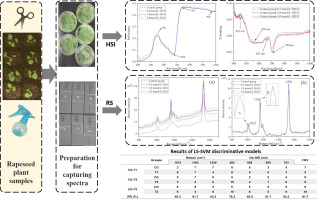当前位置:
X-MOL 学术
›
Spectrochim. Acta. A Mol. Biomol. Spectrosc.
›
论文详情
Our official English website, www.x-mol.net, welcomes your
feedback! (Note: you will need to create a separate account there.)
Potential of vibrational spectroscopy for rapid and accurate determination of the hydrogen peroxide treatment of plant leaves.
Spectrochimica Acta Part A: Molecular and Biomolecular Spectroscopy ( IF 4.3 ) Pub Date : 2020-01-16 , DOI: 10.1016/j.saa.2020.118048 Yanru Zhao 1 , Bingquan Chu 2 , Shiyan Fang 3 , Juan Zhao 1 , Haihui Zhang 1 , Keqiang Yu 1
Spectrochimica Acta Part A: Molecular and Biomolecular Spectroscopy ( IF 4.3 ) Pub Date : 2020-01-16 , DOI: 10.1016/j.saa.2020.118048 Yanru Zhao 1 , Bingquan Chu 2 , Shiyan Fang 3 , Juan Zhao 1 , Haihui Zhang 1 , Keqiang Yu 1
Affiliation

|
Detection and characterization of interactions between crop plants and hydrogen peroxide (H2O2) is significant for the exploration of the mechanisms in plant pathology. The objective of this research is to estimate spectral characteristics of rapeseed leaves (Brassica napus L.) during treatment with different H2O2 concentrations (0, 0.5, 1.0, and 3.0 mmol/L) by using Raman spectroscopy (RS) (800-1800 cm-1) and hyperspectral imaging (HSI) (400-1000 nm). Cluster analysis of RS and HSI data between the control and treated samples was conducted using kernel principal component analysis (KPCA) and principal component analysis (PCA), respectively. Characteristic Raman shifts at 1012, 1163, and 1530 cm-1 and hyperspectral featured wavelengths at 452, 558, 655, and 703 nm were selected for discriminating control and treated samples. The one-way analysis of variance (ANOVA) was applied to demonstrate the significant difference in spectral signatures of samples, and results showed that 452 nm is promising to assess the control and treated samples at the p < 0.05 level. The featured Raman shifts and hyperspectral wavelengths were employed to establish least squares-support vector machine (LS-SVM) discriminative models. The approach of multiple-level data fusion of 1163 cm-1 combined with 452 nm produced the best recognize rate (RR) of 81.7% to detect the control and treated leaves than other models. Therefore, the results encouraged multiple sensor fusion to improve models for better model performance and to detect plant treatment situations with H2O2 solutions.
中文翻译:

振动光谱法可以快速,准确地测定植物叶片的过氧化氢处理量。
检测和表征农作物与过氧化氢(H2O2)之间的相互作用对于探索植物病理学机制具有重要意义。这项研究的目的是通过使用拉曼光谱(RS)(800-1800 cm)估计在不同H2O2浓度(0、0.5、1.0和3.0 mmol / L)处理下的菜籽叶(Brassica napus L.)的光谱特征-1)和高光谱成像(HSI)(400-1000 nm)。分别使用核仁主成分分析(KPCA)和主成分分析(PCA)对对照样品和处理过的样品之间的RS和HSI数据进行聚类分析。选择在1012、1163和1530 cm-1处的特征拉曼位移以及在452、558、655和703 nm处的高光谱特征波长,以区分对照样品和处理样品。采用单向方差分析(ANOVA)来证明样品光谱特征的显着差异,结果表明452 nm有望在p <0.05水平上评估对照样品和处理样品。利用特征拉曼位移和高光谱波长建立最小二乘支持向量机(LS-SVM)判别模型。1163 cm-1的多级数据融合与452 nm结合的方法产生的最佳识别率(RR)为81.7%,以检测对照和处理后的叶片比其他模型更好。因此,结果鼓励多传感器融合以改进模型以获得更好的模型性能,并使用H2O2解决方案检测工厂处理情况。结果表明452 nm有望在p <0.05水平上评估对照样品和处理样品。利用特征拉曼位移和高光谱波长建立最小二乘支持向量机(LS-SVM)判别模型。1163 cm-1的多级数据融合与452 nm结合的方法产生的最佳识别率(RR)为81.7%,以检测对照和处理后的叶片比其他模型更好。因此,结果鼓励多传感器融合以改进模型以获得更好的模型性能,并使用H2O2解决方案检测工厂处理情况。结果表明452 nm有望在p <0.05水平上评估对照样品和处理样品。利用特征拉曼位移和高光谱波长建立最小二乘支持向量机(LS-SVM)判别模型。1163 cm-1的多级数据融合与452 nm结合的方法产生的最佳识别率(RR)为81.7%,以检测对照和处理后的叶片比其他模型更好。因此,结果鼓励多传感器融合以改进模型以获得更好的模型性能并使用H2O2解决方案检测工厂处理情况。利用特征拉曼位移和高光谱波长建立最小二乘支持向量机(LS-SVM)判别模型。1163 cm-1的多级数据融合与452 nm结合的方法产生的最佳识别率(RR)为81.7%,以检测对照和处理后的叶片比其他模型更好。因此,结果鼓励多传感器融合以改进模型以获得更好的模型性能,并使用H2O2解决方案检测工厂处理情况。利用特征拉曼位移和高光谱波长建立最小二乘支持向量机(LS-SVM)判别模型。1163 cm-1的多级数据融合与452 nm结合的方法产生的最佳识别率(RR)为81.7%,以检测对照和处理后的叶片比其他模型更好。因此,结果鼓励多传感器融合以改进模型以获得更好的模型性能,并使用H2O2解决方案检测工厂处理情况。
更新日期:2020-01-17
中文翻译:

振动光谱法可以快速,准确地测定植物叶片的过氧化氢处理量。
检测和表征农作物与过氧化氢(H2O2)之间的相互作用对于探索植物病理学机制具有重要意义。这项研究的目的是通过使用拉曼光谱(RS)(800-1800 cm)估计在不同H2O2浓度(0、0.5、1.0和3.0 mmol / L)处理下的菜籽叶(Brassica napus L.)的光谱特征-1)和高光谱成像(HSI)(400-1000 nm)。分别使用核仁主成分分析(KPCA)和主成分分析(PCA)对对照样品和处理过的样品之间的RS和HSI数据进行聚类分析。选择在1012、1163和1530 cm-1处的特征拉曼位移以及在452、558、655和703 nm处的高光谱特征波长,以区分对照样品和处理样品。采用单向方差分析(ANOVA)来证明样品光谱特征的显着差异,结果表明452 nm有望在p <0.05水平上评估对照样品和处理样品。利用特征拉曼位移和高光谱波长建立最小二乘支持向量机(LS-SVM)判别模型。1163 cm-1的多级数据融合与452 nm结合的方法产生的最佳识别率(RR)为81.7%,以检测对照和处理后的叶片比其他模型更好。因此,结果鼓励多传感器融合以改进模型以获得更好的模型性能,并使用H2O2解决方案检测工厂处理情况。结果表明452 nm有望在p <0.05水平上评估对照样品和处理样品。利用特征拉曼位移和高光谱波长建立最小二乘支持向量机(LS-SVM)判别模型。1163 cm-1的多级数据融合与452 nm结合的方法产生的最佳识别率(RR)为81.7%,以检测对照和处理后的叶片比其他模型更好。因此,结果鼓励多传感器融合以改进模型以获得更好的模型性能,并使用H2O2解决方案检测工厂处理情况。结果表明452 nm有望在p <0.05水平上评估对照样品和处理样品。利用特征拉曼位移和高光谱波长建立最小二乘支持向量机(LS-SVM)判别模型。1163 cm-1的多级数据融合与452 nm结合的方法产生的最佳识别率(RR)为81.7%,以检测对照和处理后的叶片比其他模型更好。因此,结果鼓励多传感器融合以改进模型以获得更好的模型性能并使用H2O2解决方案检测工厂处理情况。利用特征拉曼位移和高光谱波长建立最小二乘支持向量机(LS-SVM)判别模型。1163 cm-1的多级数据融合与452 nm结合的方法产生的最佳识别率(RR)为81.7%,以检测对照和处理后的叶片比其他模型更好。因此,结果鼓励多传感器融合以改进模型以获得更好的模型性能,并使用H2O2解决方案检测工厂处理情况。利用特征拉曼位移和高光谱波长建立最小二乘支持向量机(LS-SVM)判别模型。1163 cm-1的多级数据融合与452 nm结合的方法产生的最佳识别率(RR)为81.7%,以检测对照和处理后的叶片比其他模型更好。因此,结果鼓励多传感器融合以改进模型以获得更好的模型性能,并使用H2O2解决方案检测工厂处理情况。











































 京公网安备 11010802027423号
京公网安备 11010802027423号